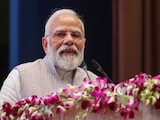To know why protests against the Modi government's new "Agnipath" (armed forces recruitment) scheme have become the angriest in Bihar, it is instructive to take a morning walk in the historic Gandhi Maidan in Patna. Birthplace of the "JP Movement" in the early 1970s, in which venerable Jayaprakash Narayan led a mighty struggle of students and youth against Indira Gandhi's authoritarian rule, this sprawling ground visually illustrates two contrasting truths about today's Young India - hope and frustration.
Hope exudes from the sight of India's globally incomparable young demography and the enormous creative potential it represents. Each morning, as I saw on a recent visit to Patna, the maidan is full of hundreds of young boys and girls undergoing rigorous physical training - sprinting, pushups, squats, lunges, crawls, surya namaskars - under the guidance of experienced instructors. These instructors are employed by dozens of training institutes that promise jobs to the aspiring youth in India's Armed Forces, failing which, in the BSF, CRPF, railway police and state police.
Gandhi Maidan in Patna (Photo credit: Sudheendra Kulkarni)
Bihar also provides another visual proof of the intense quest for jobs. Many railway stations in the state double up as spaces for coaching centres for thousands of young aspirants preparing to pass various competitive and entrance exams, including exams for the IAS, other central services and state administrative services. We don't see similar scenes in southern and western India because the economies in these states are relatively more prosperous and provide at least some employment opportunities outside the Armed Forces and government departments.
Ideally, such a huge young population should be a source of hope for India's bright future. However, frustration is evident from the stark reality that most young people will not get the jobs they aspire and are training for. The demand is so high and the opportunities are so few. This explains why Bihar, and several north Indian states, erupted in violent protests against the Agnipath scheme.
Train set on fire by Agnipath protesters in Ballia, Uttar Pradesh
Only a part of the anger can be attributed to the fact that the Indian Army had stopped recruitment for the past two years. But a bigger cause for the protesters' ire is rooted in the specifics of the scheme itself.
First: The Armed Forces have not increased the total quantum of recruitment. Only about 45,000 youths aged 17.5-21 years will be recruited, as against millions of aspirants. Of course, the Armed Forces cannot be expected to serve as an employment guarantee centre. But when the government comes with a fancy new scheme with a fancy new name - Prime Minister Modi has a penchant for nomenclaturally hyping up his yojanas - it raises the expectations of the jobless youth, especially those from poor and rural backgrounds. Hence, in purely quantitative terms, Agnipath belies their heightened expectations.
Second: What has disappointed the youth aspiring to become soldiers in the Army, Navy and Air Force even more is that out of even those recruited, only 25 per cent would actually continue in the Armed Forces. The remaining 75 per cent of the recruits will retire after four years of service without any rank and without any pension. Hence, the question the protesters are asking is genuine: "Why has the government coined a nice-sounding name 'Agniveer' for the recruits if three-fourths of them are going to be unemployed after only four years?"
Army aspirants demonstrating against the Agnipath recruitment scheme in Gwalior
Third: The answer to this given by the defenders of the scheme is that the retirees would be young enough to continue their education or look for other jobs. Furthermore, they would have earned about Rs 10 lakh by then. They overlook an important sociological fact which is absent in western countries. An opportunity to serve the Armed Forces brings enormous social prestige to the 'fauji', especially in rural and mofussil India. As a matter of fact, many of those aspiring to become solders come from the farming community. The slogan 'Jai Jawan Jai Kisan', popularised by India's second Prime Minister Lal Bahadur Shastri at the time of the 1965 Indo-Pak war, continues even now to evoke a strong sense of patriotism in non-metropolitan India. Therefore, to be called an 'Agniveer' after getting recruited, and then finding oneself rejected after four years, is not a source of personal or national pride for the person concerned. It is indeed a source of disillusionment. Moreover, those who belong to the 75 per cent category would be looked upon as failures by their families, communities and villages.
Those who travel in rural India will not miss this point. Whenever a person gets selected in the Indian Army, the entire village rejoices and hoardings are put up to congratulate the jawan for bringing pride and prestige to the village. Imagine the plight and the sense of humiliation felt by the Agniveers, who are so hailed by their village communities, and who return as rejects from the Armed Forces after four years.
Fourth: There is yet another deeply disconcerting fact associated with the problem of unemployment in India. It is not just that jobs are had to come by but that most jobs that young people do get are now on 'contract' basis with no job security and no social security (pension, etc). A school teacher's job was once regarded as highly prestigious in rural India. A part of the reason for this was that a teacher remained a teacher for at least 30-40 years of his or her life and became an integral - and often respected - part of the village community. But now, in state after Indian state, both in government and private schools, teachers are hired on a temporary contract basis, mostly on pitiably low salaries. Contractualisation and informalisation of employment has become the norm in India in most sectors.
If Agniveers also become victims of such short-term contractual employment, two consequences will follow: the 75 per cent failed Agniveers will have no special respect for, or lifelong commitment and gratitude towards, the Armed Forces. More worryingly, the attitude of poorer and rural communities, from which most Agniveers will hail towards 'Bharat Ki Sena' will also gradually change. (Metropolitan upper classes never send their children to serve as soldiers.)
Violence in any protests is undesirable and must be condemned. Nevertheless, one cannot overlook the Modi government's utter failure to communicate the objectives of the new scheme, which it is belatedly trying to do now. Had the government held prior consultations with state governments, veterans of armed forces, youth groups (such as training institutions), and perhaps implemented it gradually, society would have been better prepared to accept it. Sadly, consultation with stakeholders is something the BJP government has never believed in. The country had seen this contempt for dialogue it during last year's prolonged farmers' agitation against the three undemocratically enacted Farm Laws. The Prime Minister was forced to withdraw those. He may well find himself compelled to do the same in the case of the Agnipath scheme, or at least modify some of its features to satisfy the agitating youth.
(The writer was an aide to India's former Prime Minister Atal Bihari Vajpayee.)
Disclaimer: These are the personal opinions of the author.















